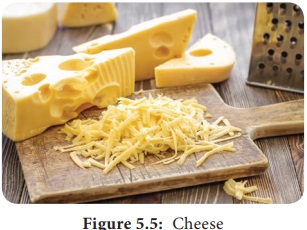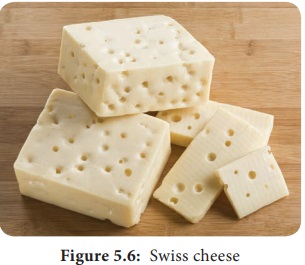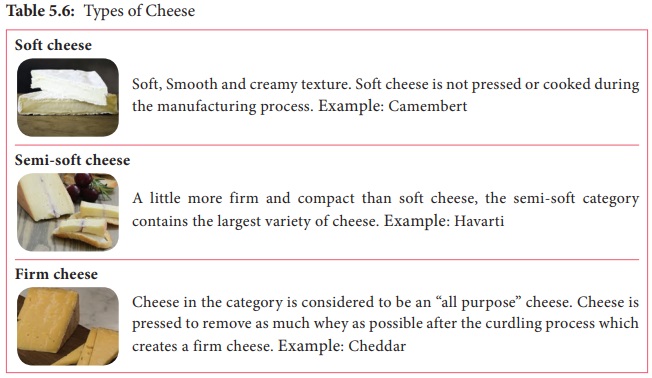Types, Diary Microbiology - Cheese | 12th Microbiology : Chapter 5 : Food Microbiology
Chapter: 12th Microbiology : Chapter 5 : Food Microbiology
Cheese
Cheese
There are
about 2000 varieties of cheese made from mammalian milk. Cheese is thought to
have originated in south western Asia some 8000 years ago. The Romans
encouraged technical improvements and stimulated the development of new
varieties during their invasion in Europe between 60 B.C and A.D. 300. The
cheese name is derived from Latin name caseus
(Figure 5.5).

They are two groups of cheese, fresh cheese and ripened cheese. The fresh cheese are made up of milk coagulated by acid or high heat. Example: cottage cheese. Ripened cheese are made through lactic acid bacterial fermentation and coagulated by an enzyme preparation. The curd is removed and salted and whey is separated. The salted curd is held in controlled environment. During this process, various physical and chemical changes occur to give a characteristic flavour and texture. So the mammalian origin of milk influences the flavour and aroma of a natural ripened cheese.
Microbiology of cheese
A large
number of microorganisms plays a role in the ripening process. On the first day
of cheese making process, the microbial number in the starting material ranges
from one to two billion. Therefore, the production declines because of
insufficient oxygen, high acidity and the presence of inhibitory compounds that
are produced as the cheese ripens. It is mainly the action of their cellular
enzymes on lactose, fat and proteins that creates the ripened cheese flavour.
The gas forming culture of Propionibacterium
shermanii is essential for giving swiss cheese its eye, or holes and
flavour (Figure 5.6).

The
specificity of cheese depends upon the varieties of microorganisms used. The
process of cheese making, involves nine steps:
a. Preparing
the milk
b. Forming
a curd.
c. Cutting
d. Cooking
e. Separating
the whey
f. Salting
the residue
g. Applying
microbes
h. Pressing
the curd
i. Ripening
the young cheese
Types of Cheese
Cheese
can be divided among different categories or types, according to their
firmness. There are various system for classifying cheese and there are variations
within each system (Table 5.6).


Types of Cheese
Soft cheese
Soft,
Smooth and creamy texture. Soft cheese is not pressed or cooked during the
manufacturing process. Example: Camembert
Semi-soft cheese
A little
more firm and compact than soft cheese, the semi-soft category contains the
largest variety of cheese. Example: Havarti
Firm cheese
Cheese in
the category is considered to be an “all purpose” cheese. Cheese is pressed to
remove as much whey as possible after the curdling process which creates a firm
cheese. Example: Cheddar
Hard cheese
Hard
cheese has a moisture content of less than 50% due to the cheese being the
cheese to lose some of its moisture content and have a stronger flavour.
Example: Romano
Blue cheese
Cow,
sheep or goats milk with a blue or green-blue mold. The mold is derived from
spores from Penicillium roqueforti, Penicillium glaucum or other being injected
into the cheese curds. People who are allergic to penicillin are not advised to
eat blue cheese. Example: Roquefort
Fresh, un ripened or infant cheese
Fresh
cheese is not ripened, aged or fermented during the manufacturing process or at
any point during the lifespan of the cheese. Fresh cheese has a very short
shelf life. Example: Cottage cheese, Cream cheese.
light or lite cheese
Light
cheese is made by reducing the amount of butterfat which makes the cheese
rubbery in texture and much less flavourful than full fat versions of cheese.
Light cheese has a high moisture content which makes it have a shorter shelf
life. Example: Cheese with 7% Milk Fat, Cheddar which 19% Milk fat.
Processed cheese
This
cheese is created by melting together blend of grated cheese, milk, milk solids
or water, food colouring and seasonings. Example: Processed cheese shies,
cheese spreads “swokies”.
Related Topics